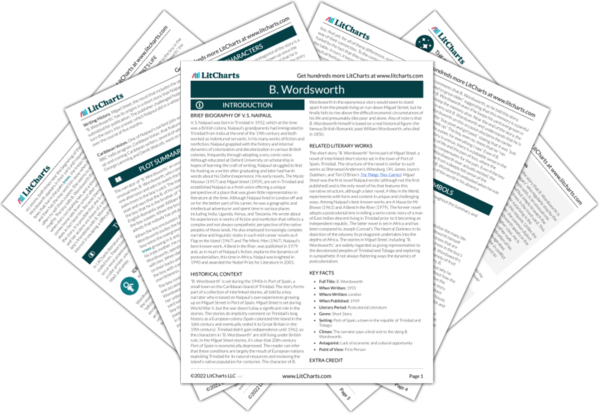Identity Construction
In “B. Wordsworth,” the titular character creatively constructs an identity for himself, effectively choosing the kind of person he wants to be. That B. Wordsworth introduces himself to the boy in the beginning of the story as “Black Wordsworth” and says he is the brother of “White Wordsworth,” the 19th-century English Romantic poet, immediately suggests B. Wordsworth’s interest in constructing an identity oriented around the idea of fostering a poetic relationship with the world. His…
read analysis of Identity ConstructionArt and the Artist’s Life
B. Wordsworth introduces himself to the boy in the beginning of the story as “Black Wordsworth,” the brother of “White Wordsworth,” or William Wordsworth, a 19th-century English Romantic poet who believed in cultivating a meaningful and immediate relationship to the natural world. B. Wordsworth claims that he is a poet and tells the boy that he’s writing one line of poetry each month with the intention of eventually creating “the greatest poem in the world.”…
read analysis of Art and the Artist’s LifeUnconventional Friendship
“B. Wordsworth” demonstrates the power of friendship to transcend arbitrary differences that might otherwise keep people apart. By most accounts, the young boy and B. Wordsworth have very little in common. B. Wordsworth is much older than the boy, and he speaks in a completely different style—a style that is reminiscent of a well-educated, upper-middle-class British man. The boy, on the other hand, speaks in the common dialect of Trinidad and Tobago. And yet, they…
read analysis of Unconventional Friendship
The Wonder of Nature
An appreciation for the wonder of a nature is central to B. Wordsworth’s worldview and to his friendship with the boy. The boy meets B. Wordsworth when the latter comes to his door requesting to “watch the bees” that have taken over the palm trees in the boy’s yard. B. Wordsworth’s interest in the bees signals a crucial preoccupation for him—the wonder of the natural world. This sense of wonder is one that…
read analysis of The Wonder of NatureLiving and Dying
The joy of living and the sorrow of death are deeply intertwined in “B. Wordsworth.” Midway through the story, the boy asks B. Wordsworth about his overgrown yard. When B. Wordsworth tells him a story that suggests that his pregnant wife and unborn daughter died, the boy comments that B. Wordsworth, as he told this story, “seemed to grow older,” suggesting that this memory is a painful one for B. Wordsworth even if he keeps…
read analysis of Living and Dying






